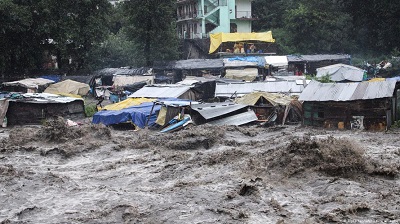Shimla, (Asian independent) Himachal Pradesh is still recovering from one of its worst disasters in a century, which claimed over 400 lives with a cumulative loss of over Rs 10,000 crore following torrential rains that triggered landslides, flash floods and cloudbursts during the 2023 monsoon, leaving thousands of families homeless.
Terrifying visuals of landslides sweeping away several multi-storey buildings and hundreds of people being evacuated and rescuers searching for people feared missing in the northern Himalayan state were common in the August-September calamity.
Scientists say the frequent floods and devastation in the Himalayan states of Himachal Pradesh and Uttarakhand are proof of the increasing climate risks to an already vulnerable and fragile ecosystem.
They attribute rising temperatures to the increased atmospheric evaporation and humidity levels for the sudden extreme rains.
The constant rise in land and sea temperatures has made the Himalayas vulnerable to torrential rains and these compound disasters.
The Himalayas are recognised as a global hotspot vulnerable to greenhouse gas emissions. Experts have already warned against the unprecedented rise in extreme weather events and unplanned development projects.
The southwest monsoon of 2023 is a reflection of what climate change impacts would do to the Himalayas if global warming goes unchecked, remarked an expert.
What does science say about the sensitive Himalayan region?
The rise in extreme weather events is unprecedented, and they have been multiplying rapidly.
The monsoon of 2023 is an apt reflection of what climate change impacts would do to the Himalayas if global warming goes unchecked.
Climate scientists say more heating means more extreme rainfall. The atmosphere, land and oceans are all warming at a faster rate.
The warmer it becomes, the more moisture the atmosphere can hold. This has led to more water being evaporated from the Earth’s surface.
This increases the holding capacity of the air, which results in more droplets and heavier rainfall, sometimes in a shorter space of time and over a smaller area.
Experts told IANS that humidity is the prime factor behind the increasing likelihood of heavier rainfall and even more dangerous heatwaves.
Both humidity and temperature are the twin pillars of climate change. There has been a change in the western disturbance trajectory of late. They are more prevalent during winter when they travel in lower latitudes, bringing rain and snow over northern India.
During the summer, these systems tend to travel in higher latitudes and do not have much impact on the region.
“In July (2023), we witnessed record-breaking rains across Himachal Pradesh and Uttarakhand, for which the weather conditions were responsible. The reason was the interaction of two different weather systems. A very strong western disturbance interacted with the monsoon enhancing the influx of moisture, rainfall and floods.
“Conditions were similar to the Uttarakhand tragedy in June 2013. There is a bit of a tendency for western disturbances to impact the northern Indian region during this time, which is very unusual. Western disturbances are more active during winter but are now more active during the monsoon,” said Akshay Deoras, Meteorologist and Research Scientist, National Centre for Atmospheric Science and Department of Meteorology, University of Reading, United Kingdom.
The science of global warming is clear. “If we continue to emit more and more greenhouse gases into the atmosphere, especially CO2, it will enhance the air’s capacity to hold more and more water. Now, whenever favourable weather conditions appear, for example, in the case of break monsoon conditions, the air will release much more water vapour in the form of rainfall. This means the probability of an ordinary rainfall event intensifying into a heavy or extremely heavy one will increase because of global warming,” he added.
The ferocious Beas River ate up a large part of a highway running parallel to the riverbank and washed away at least nine bridges in Mandi and Kullu regions, snapping even pedestrian movement.
The damage to roads has been extensive in Kullu, Mandi and Shimla districts. For the first time, the bottom of the century-old Shimla-Kalka railway line was swept away in the landslide near Shimla and is hanging in the air.
According to the Intergovernmental Panel on Climate Change’s Sixth Assessment Cycle Report, warming in the Himalayas has increased with altitude. Such elevation-dependent warming could lead to faster changes in the snowline, the glacier altitude and the snow and rain transition height.
This means the quantum of weather activities would undergo significant changes.
Explaining the phenomenon, Professor YP Sundriyal, Head, Department of Geology, HNB Garhwal University, Srinagar, Uttarakhand, said, “The Shivalik range is the youngest and most fragile part of the Himalayas as they are made up of debris. Rocks are made up of sandstone and shale rock, which is the weakest form of any rock, and they cannot withstand heavy rains as their composition is of clay minerals.
“The increasing torrential rainfall, deforestation, and unchecked construction have increased the chances of erosion. As humans, we have been challenging these mountains’ capacity for many years now. Increasing anthropogenic stress will only lead to disaster.”
Scientists call for immediate climate action as vulnerable mountain communities are already experiencing significant adverse impacts like loss and damage to lives, property, heritage, and infrastructure.
Floods and landslides are projected to increase and the effects on fragile mountain habitats are particularly acute.
Anjal Prakash, Clinical Associate Professor (Research) and Research Director, Bharti Institute of Public Policy, Indian School of Business, told IANS the tragic loss of lives and devastation caused by the recent landslides and flashfloods in Himachal Pradesh served as a stark reminder of the intensifying impact of climate change on vulnerable regions.
“As climate change accelerates, the frequency and severity of such natural disasters is rising. The vulnerability of hillside communities and the crumbling of essential infrastructure further magnify the tragedy. Immediate action is imperative,” he added.








